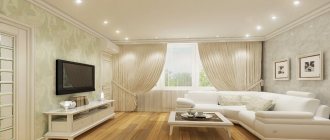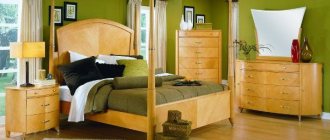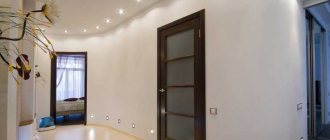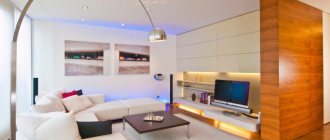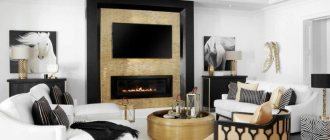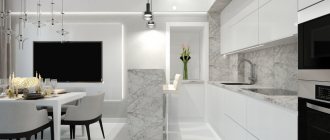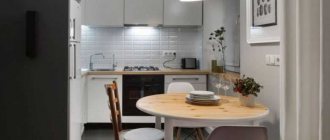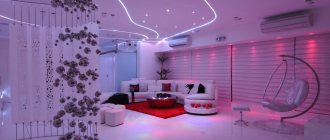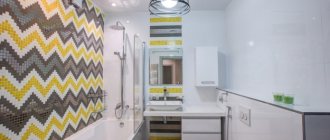Light zoning has long been used in the design of residential and work spaces, because the right combination of natural and artificial light can transform any space. Lighting in an apartment requires careful preparation and adherence to certain design rules. A well-chosen scheme can visually increase the area of the room and hide design mistakes, while an unsuccessful one will only aggravate the interior’s shortcomings. In this article we will look at how to choose light sources for different rooms, and also analyze current trends in this direction.
How to properly organize lighting?
Lighting planning is an integral part of renovation work. This process must be started at the design stage. The organization of light in an apartment should begin with dividing the room into several thematic zones. In the classic version, lighting is divided into two types: general (basic) and local.
Local lighting is intended to illuminate specific interior elements or corners of the apartment, while general lighting serves as a key element of artificial light.
In turn, local illumination is of the following types: working and spot. Most rooms provide a so-called work area (kitchen table, office, children's play corner). To ensure sufficient illumination, large chandeliers, floor lamps and sconces are used.
Spot light supply is most often used as an additional element; it performs a purely decorative function.
A distinctive feature of artificial light is the ability to use it at any time of the day or night. By changing the color of the light zoning, you can instantly change the proportions of the room and divide the room into functional zones.
It is also worth noting that the shade of light greatly affects the human perception of reality. Let's give an example: green color calms, and yellow uplifts. Thus, when choosing a lighting scheme in an apartment, it is necessary to take into account the functionality, safety and aesthetics of the design.
Power standards and number of lamps
To achieve the most efficient and comfortable lighting in the interior of an apartment, you should take into account uniform standards for the power and number of lamps in the illuminated area. Thus, experts advise placing devices with a power of about 70 kW for every five square meters of the room. This indicator may vary depending on the specifics of the room. Moreover, we are talking only about central lighting; it can be supplemented with various kinds of decorative or point light sources.
Having studied the basic requirements for illumination of residential premises, you can independently calculate the required number of lamps for the apartment. You are also free to use all sorts of design tips. Most often, they consider the organization of electric lighting in studio apartments.
For a one-room home with an area of 30 square meters, you need about eight lamps (one central chandelier, task lighting, three spotlights, a floor lamp and several sconces).
Example of lighting in a one-room apartment
How to check the quality of light?
When purchasing a chandelier or any other lighting fixture, you first need to find out what kind of lamp is used in the installation. The most common option is an incandescent lamp - it gives a bright, uniform glow. However, the disadvantage of this type of device is the rapid consumption of electricity.
Today, most lighting companies are switching to energy-saving lamps. Their cost is slightly higher, but reliability and low electrical costs worry buyers no less than the price.
There is one simple way to check the quality of light in a chandelier; for this you will need a mobile phone. Hold the device close to the light fixture and turn on the camera, watching the moving light bars on the screen. If you notice significant flickering and numerous streaks, know that the quality of the light leaves much to be desired. In this case, it is better to immediately replace the product, because over time you and your family members may begin to have vision problems.
Colorful temperature
As already mentioned, the color temperature of the lamps plays an important role in light zoning. There are three colors: warm white (up to 3300 K), standard white (up to 5000 K) and cool white (from 5000 K). In accordance with European standards, it is customary to use warm white light in living rooms, but in secondary rooms, such as the hallway, it is recommended to use classic white.
Related article: Lighting for a children's room: tips on organization
Sources of light
Today, a variety of light bulbs, all kinds of chandeliers, sconces and floor lamps are used to illuminate apartments. Specialized stores in Moscow and other large Russian cities offer a wide selection of similar products for every taste and budget.
The following are used as a direct light source:
- incandescent lamps;
- LED devices;
- fluorescent lamps;
- optical fiber;
- metal halide light bulbs;
- halogen bulbs.
All of the above types have both advantages and disadvantages of use. Let's take a simple example: previously popular incandescent lamps do not correspond to modern trends, since they consume a large amount of electricity and the quality of light is very low.
Natural light
The best decoration for a wooden country house, or even an ordinary apartment, is natural lighting. It not only does not harm vision and has a positive effect on people’s well-being, but also looks impressive in any interior. To fully enjoy living light, private houses have full-wall windows; it looks simply amazing. However, this effect is very difficult to achieve in a one-room or two-room apartment.
Artificial lighting
There are many options for lighting in an apartment, but not everyone suits the chosen style of the room. It is worth remembering that artificial light involves not only the installation of expensive lamps. This process should be approached responsibly, because the health of a person’s eyes and nervous system depends on the final result.
To create a functional light zoning system for an apartment, you need to familiarize yourself with the installation capabilities of the devices in advance. The photo below shows a universal living room design using different types of lamps.
On video: what you need to consider when designing lighting.
Types of lighting
There are four types of artificial light: general, local, combined and emergency. The latter type is not often found in residential premises, but it is indispensable in rooms where turning off the lights threatens serious injuries. Next, we will consider all types of lighting in apartments in more detail.
General or basic lighting involves uniform (directional) dispersion of light across the entire area of the room. Most often this type is used in living rooms and kitchens. Due to the same distance between the lamps, an optimal level of illumination is achieved. Another option for such light zoning is a single light source localized at one point. As an example, there is a large chandelier located in the center.
Local lighting in the apartment is used to attract attention to certain parts of the room. Thus, the light source is located directly next to the illuminated piece of furniture (on the desktop, in the sleeping area or in the kitchen). As the designers note, it is this type of light zoning that brings completeness and integrity of perception to the interior space.
Separately, general and local lighting have certain functional disadvantages. That is why a combined light zoning scheme was developed.
Spotlights
Since then, when European-quality renovations began to be carried out everywhere in Russian apartments, spotlights have appeared on ceilings, walls and decorative objects. Such built-in lighting fixtures are becoming more and more popular over time. Now you won’t surprise anyone with a multi-level ceiling with halogen light bulbs.
It is worth noting that there are two types of spotlights - fixed and rotating. The latter are very convenient to use, and if desired, you can change the direction of the light yourself.
When choosing such devices, pay attention to the beam width. Let's give an example: 40-50 degrees is great for highlighting large objects, and halogens with a beam of 10-20 degrees are suitable for minor decorative elements.
Neon lamps
Neon lighting is a special type of artificial light, which is a gas-discharge lamp in the shape of a tube (neon is contained inside at low pressure). The “native” shade is bright orange, but the color of the backlight may change depending on what inert gases are added to the composition.
A neon lamp will help bring color to the interior of your apartment. The photo below shows the lighting design in the apartment in pink and purple tones.
LED strips
Recently, various LED devices have been used for decorative lighting of rooms. The most popular is LED strip. This is a flexible board covered with LEDs. Bright neon colors, unusual appearance and low price - all this makes this light source an excellent addition to the exterior lighting of a wooden house.
For interior decoration, such lighting can be used both on the ceiling, walls, and on small built-in structures. For greater effect, you can arrange the feed in the form of graphics, thereby creating a unique atmosphere.
LED duralight
For additional illumination of individual parts of the room, various LEDs are used, as well as a new product on the market, “duralight”. This functional device is a flexible cord made of elastic plastic. A continuous garland of LED light bulbs is pressed into the base.
Article on the topic: Chandeliers in the interior of different styles: help in choosing (+130 photos)
Flexible neon
It is also a flexible tube, inside of which a lighting circuit is fixed. This is nothing more than an electroluminescent wire. Outwardly, it is really no different from a regular wire - it is just as flexible, it can even be tied into a knot.
Unlike LED strips, flexible neon glows from all sides, it is safe and even waterproof, and has a wide range of applications.
Examples of lighting in different rooms
But theory is theory, and the best question is: how to properly make lighting in a room, consider specific examples. To do this, let's look at the lighting system and its regulation for each specific room.
Bedroom
Let's start with the most intimate room in the apartment - the bedroom. You don't need too much lighting here. According to the standards, 150 lux is generally sufficient here.
In this case, it is desirable that the light be warm. Light in the range of about 2700 K is considered warm. You can find the light range of the lamp in the product data sheet.
Example of general bedroom lighting
So:
- General lighting in the bedroom is best achieved through several diffused light spotlights. You can use a not very bright chandelier with a small number of lamps. The light reflected from the ceiling will also look good in a multi-tiered suspended ceiling.
- Lamps on the bedside table have become an almost obligatory attribute of any bedroom. They should provide soft diffused light and completely eliminate glare.
Local lighting for the bedroom
- If you like to read in bed, then you will need a local lighting lamp. For these purposes, it is better to choose products with adjustable light direction. The lamp itself must produce a directional luminous flux. By the way, for these purposes it is better to choose lamps with a neutral white color in the range of about 4000 K.
- The last element is decorative lighting. There are several options here. If there are 1 - 2 elements that you want to highlight, then it is best to do this through a directed flow of light from the ceiling. If there are no such elements, then you can use lamps installed at floor level. They will illuminate the wall and create an intimate atmosphere in the room.
Decorative bedroom lighting
The lighting in the room can be adjusted using dimmers. Now there are devices on a remote control that allow you to control the dimmer from a distance. But here it should be remembered that diode lamps, as well as some other types of lamps, cannot adjust the brightness of the light flux.
Living room
Next in importance is the living room. There is no single style of lighting system for this room. After all, the purpose of this room may differ significantly, depending on your preferences.
If you need a living room to relax in a chair with a book or just curl up in front of the TV, then this is one thing. If you need a room for meetings with friends and noisy holidays, then the lighting system requires a completely different one.
Warm general lighting for the living room
- However, any living room should have overhead general lighting. As in a small room, side-type lighting will not work here. Depending on the style of the room, you can install a huge beautiful chandelier here, or you can get by with diffused light spotlights. Sometimes general lighting is made on two levels. One level for quiet gatherings with family, and brighter lighting for noisy company.
Cool living room lighting
- If part of the room is reserved for a study or has another purpose, then it is highlighted with zone lighting. The style and type of this lighting depends entirely on the interior of the room.
Zonal lighting of the living room
- Local lighting in the living room is used extremely rarely. However, if necessary, you can install a directional lamp. If the place that requires additional lighting does not change, then you can use a directional spotlight that will be directed to the required point.
Decorative lighting for the living room
- Decorative lighting in the living room can be represented by directional lamps - to highlight certain interior details. Lamps installed at floor level with wall lighting can be used.
You can also experiment with the color emitted by the lamps and use diode strip to highlight individual elements - for example, a multi-level floor. Or, as when lighting attics, try to create a pattern with light on glass or a wall.
Children's
The children's room should be filled with light. The minimum permissible level of illumination for it is 200 lux, and is one of the highest values for an apartment.
For general lighting, it is better to use lamps that produce white light in the range of about 4000 K. But in the work area, you should use lamps that produce cold light in the range of about 6000 K.
Uniform general lighting of the nursery
So:
- For general lighting in a children's room, its uniformity is extremely important. Therefore, the best option here would be to install diffuse spotlights. Various systems of dim or reflected light will not work here.
Night light with dim warm light
- For children of primary preschool age, it is important to have a night light. This could be a decorative lamp on the bedside table, or it could be a dim lamp on the wall. For such lighting, you should choose warm light in the range of about 2700 K. Care should be taken to ensure that it produces a minimum of shadows.
- A separate issue is the work area for school-age children. There should be enough lighting here for fruitful work. It can be implemented using directional spotlights. They will not only provide the proper level of illumination, but also visually highlight the work area.
Fiber optic lighting for children's rooms
Wall lighting of the room and directional lamps can play a decorative role. But it is better to abandon a variety of floor and low-mounted lamps in favor of safety.
To create a fabulous atmosphere, you can use fiber optic lighting or other similar devices.
Hallway
The very first room your guests see is the hallway. It should be cozy and bright here. At the same time, too bright light can cause irritation. Based on this, it is better to use warm colors in the hallway around 2700 K.
General lighting in the hallway
Example of general hallway lighting
- General lighting in this room can be done with diffuse spotlights, like lighting in a dressing room. If the room is spacious enough, then you can use the type of lighting reflected from the ceiling.
Decorative lighting in the hallway
- Local lighting is not used in this room. But decorative lighting can be used. This can be done using lamps installed at floor level; lamps on the wall look interesting, like in the video.
Reflected from the ceiling, general lighting in the dressing room
If you have decorative elements that you want to highlight, you can use additional lighting from niches, or use spotlights. Through the skillful use of shadows, you can visually enlarge the room.
Kitchen
The kitchen is one of the most important rooms in any home. This room often becomes not only a family gathering place, but also a place for discussing news, gatherings over a cup of tea and, of course, is a purely unitary room for cooking. Therefore, in the kitchen it is necessary to combine functionality, convenience and beauty.
General kitchen lighting
- In order to fulfill all these requirements, this small room is usually divided into two zones - the kitchen and the dining area. Lighting for these zones should also be made separate.
The photo shows general lighting for a small kitchen divided into zones
- General lighting for the kitchen should be bright, but in the dining area it is better to dim it. This can be done by unevenly installing diffused lighting spotlights. In addition, you can use lamps of different color ranges. For the kitchen area these are white lamps, about 4000 K, and for the dining area - lamps about 2700 K.
Lighting for the working and dining area in the kitchen
For the dining area, it is now fashionable to create general lighting using low-mounted lamps. This has its reason, because in this way the light falls only on the table.
At the same time, such lamps do not require special brightness. Here you can focus on their appearance.
Kitchen work area lighting
- One of the main ones for the kitchen area is workplace lighting. Even the standards require it to be provided at a level not lower than 300 lux. You can do this yourself. To do this, you can use lamps mounted in a wall cabinet. An interesting solution is aprons that emit light, as well as fluorescent lamps or other luminous strips installed in the upper part of the apron.
Note! When installing lamps in a wall cabinet, make sure that they are slightly recessed into the furniture. If the lamp protrudes, it will give a blinding effect. The same applies to the luminous stripes on the apron. But you won’t be able to drown them, so you should use lamps that dim the direct light.
- Decorative lighting for the kitchen can be very diverse. But here a lot depends on the size of the room. After all, decorative lighting in a small room is extremely difficult to implement, and often useless. Therefore, only owners of large premises should think about decorative delights.
Decorative lighting for the kitchen
The entire reserve can be used for this purpose. These include directional lamps installed in different places; this is contour lighting; This is the illumination of niches and the use of lamps of different colors.
Lamp placement options
The main rule of design is that bright light increases the space. It follows from this that the finishing of the ceiling and walls should be done using all kinds of reflective materials. Lamps directed upward visually make the ceiling higher. And to darken part of the room, you just need to correctly distribute the light sources around the room.
New ideas in lighting design state that universal electric lighting at home should combine general and local (spot) lighting. This is guaranteed by the so-called multi-level zoning.
There are no strict rules for organizing electric lighting in apartments, but there are certain tips that should be followed when planning the interior yourself.
Living room (hall)
The main source of light in the room is central lighting; this can be a luxurious chandelier or a series of spotlights laid out around the perimeter of the room. For classic interiors, the first option is suitable, but when arranging modern apartments, you should first of all focus on the preferences and material capabilities of the residents.
For a living room (hall) in a high-tech style, neon lamps, LEDs, and even a light floor are suitable.
Bedroom
As in other living spaces, it is best to use combined lighting in the bedroom. A chandelier and several floor lamps are suitable as base light, and spotlights along the perimeter of the ceiling will only complement the overall picture. You can also transform your bedroom with the help of local lighting fixtures - they are very inexpensive, and the range of their purposes is very diverse.
Children's
The child spends most of his time in his room. This determines a large number of requirements for the lighting design of a nursery. It is necessary to choose lighting fixtures of suitable power and shade, because the mood and psychological health of the baby depend on proper planning. Particular attention should be paid to decorative lighting in a children's room. The photo below shows options for light zoning for children's rooms.
Kitchen
The kitchen is characterized by multi-level lighting. It involves a visual division of the room into functional areas: dining room, workplace and relaxation area. In the kitchen, it is necessary to provide the ability to regulate the brightness of the light - this is especially important for the dark time of day.
In the kitchen, the selected type of lighting can work independently of other lighting elements. Even if the room only has central lighting, make sure that it can be turned on in parts.
Hallway
There is absolutely no natural light in the hallway and corridor, so the room needs a large number of built-in lamps. There are no special requirements for organizing light in the corridor; everything depends only on the tastes of the residents.
Bathroom
There is no natural light in the bathroom (no windows), due to which the role of artificial light increases significantly. The use of local high-power appliances is unacceptable for the bathroom. The backlight should be sufficient, but not too bright. When choosing bath fixtures, it is necessary to take into account the increased humidity of the room.
Light zoning in a studio apartment
Most often, light zoning is used specifically in studio apartments, since in such rooms there is a problem of lack of free space. Dividing the apartment into thematic zones allows you to visually increase the area of the room and give the home a logical completeness.
In such conditions, you can experiment with lighting devices - use local devices, large chandeliers, and decorative elements.
Wall flat lamps in a children's room
For a children's room, it is better to opt for flat lamps on the walls. They will serve as a source of light at night. Currently, there is a large selection of lamps of various shapes and colors that suit the overall style of the room.
view album in new window
Ceiling lighting
Modern lighting design ideas give a special role to ceiling lighting. In most cases, the choice of lighting fixtures evokes positive emotions, but placing purchased light bulbs and hiding them (when creating hidden lighting with your own hands) is not always easy. Before starting the installation of spots, it is recommended to identify three main light sources in the interior (local, local and decorative).
For low ceilings
If the ceiling in the apartment is quite low, then there can be no talk of any tension or even suspended structures. Hanging chandeliers and massive lamps are not suitable. Recessed spotlights cannot be built in here, but overhead versions can be installed. Flat-shaped ceiling chandeliers, track lighting systems and LED panels will fit harmoniously.
Hidden ceiling lighting
You can build two types of hidden lighting with your own hands: using a niche made of plasterboard and with a cornice made of polystyrene foam. And the combination of a plasterboard box and a stretch ceiling with hidden lighting perfectly hides minor errors that occur when constructing a ceiling yourself.
Related article: How to organize lighting in an apartment: diagrams and rules (installation of electrical wiring)
Consecration scenario
In most cases, the bedroom is used not only for sleeping. To use it for other purposes, you should definitely consider the saturation of the lighting.
A chandelier is used for central lighting, and lamps are used for local illumination.
The most convenient are devices that allow you to adjust the brightness of the lighting.
When choosing a chandelier for central lighting, attention is paid not only to the brightness of its glow, but also to the design. It is important that the item fits into the overall interior of the room.
Multi-level lighting
For a comfortable stay, you cannot do without proper lighting of the room. For more than ten years now, all designers have been leaning in their work towards a multi-level light system in apartments. Such light zoning represents the optimal division of space into several functional zones.
It is customary to distinguish four main levels:
- upper (spots, sconces and chandeliers);
- medium (lamps, floor lamps);
- bottom (local illumination);
- internal (used to highlight dressing rooms and closets).
Multi-level zoning of rooms using light does not require special skills and knowledge. If you wish, you can radically transform the appearance of your living room or children's room with your own hands. To do this, you will need a little imagination and a set of lighting fixtures with different functionality. A competent combination of chandeliers, spots on the walls and floor will bring comfort and tranquility to your home.
In the video: multi-level lighting in the apartment.
Highlighting the dining area with a lamp
With the help of light, designers highlight different zones. This is especially true for studio apartments, where you need to focus on a specific functional area. The dining area can be highlighted with a lamp located above the table.
view album in new window
A chandelier on a low suspension is placed parallel to the surface of the dining table, which will create uniform illumination of this area. Compositions in which the shape of the lampshade is the same as that of the piece of furniture look original.
Decorative lighting
An inexpensive LED strip is most suitable for decorative lighting. The positive features of this product include ease of use, easy and quick installation. If the interior of the room is made in a classic style (with wooden furniture, pastel shades of the walls and tapestry), then the LEDs are replaced by local lamps and special luminous elements for decoration.
A distinctive feature of decorative lighting is the specificity of its use. It is used when it is necessary to hide lamps and make the light more subdued.
Neon lighting in the apartment
Such decorative lighting can be arranged using various LED and LED devices. Most often they are installed in suspended ceilings, in plasterboard niches. Flexible tubes or cords that glow with neon are often used.
Glass blocks in the interior of an apartment with lighting
Glass blocks are hollow cubes with glass walls about one centimeter thick. In Soviet times, such decorative elements were often used; they could be seen in the interior of bathhouses, hospitals, and staircases. Today, glass blocks have been improved - they are equipped with decorative lighting.
Floor lighting
Floor lighting is another solution with which you can give the room an unusual look. Various devices are used for lighting, these can be spotlights, LED strip, duralight cord, which are mounted in the plastic baseboard case or in glass floors.
Modern lighting trends
Lighting design is a unique combination of technological advancement and artistic planning. All new design trends come first to the light zoning of rooms, and then spread to the entire interior. A distinctive feature of modern design is high functionality; this is the so-called smart design, which is aimed at satisfying all the needs of its owner. This trend is called lighting personalization.
If you carefully study the appearance of modern lamps, it becomes clear that they have completely lost clearly defined boundaries. Nowadays, round, asymmetrical, small-sized built-in spots are especially popular in interior design. Track systems have become an integral part of the ceiling, which has also lost its boundaries.
Night lighting in the apartment
Night lighting is not a significant necessity when decorating interior spaces. However, it allows you to avoid accidents in the dark. You can install night light along the perimeter of strategic movement or in separate areas of the room.

